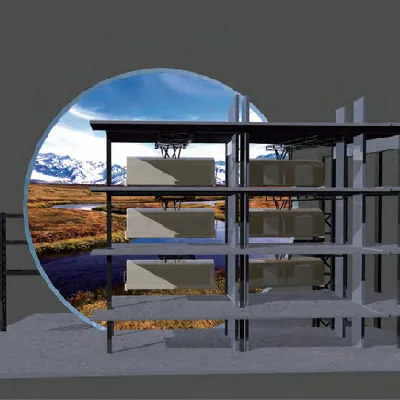- Albanian
- Arabic
- Belarusian
- Bengali
- Czech
- English
- French
- German
- Hebrew
- Hungarian
- Indonesian
- irish
- Italian
- Japanese
- kazakh
- Persian
- Russian
- Thai
- Uzbek
- Vietnamese
Creative Rollercoaster Architect Crafting Unique Thrill Rides for Amusement Parks and Fun Seeking Adventures
The Art and Science of Roller Coaster Design
Roller coasters have long been a hallmark of amusement parks, thrilling riders with their high speeds, steep drops, and upside-down inversions. The design of these exhilarating attractions is a complex blend of art and science, requiring a deep understanding of physics, engineering, and design aesthetics. This article explores the multifaceted process of roller coaster design, from conception to completion.
The Genesis of Ideas
The journey of a roller coaster begins with the initial concept. Designers often draw inspiration from various sources, including nature, architecture, and even pop culture. Brainstorming sessions involve sketching ideas for layouts that will create the ultimate thrill experience. These early designs are imaginative, focusing on unique elements like loops, corkscrews, and airtime hills, but they must also be feasible.
Principles of Physics
At the heart of roller coaster design is the application of physics. Designers must understand the principles of dynamics, gravity, and centripetal force. For instance, the height of the initial drop is crucial; it determines the ride's potential energy, which is converted to kinetic energy as the coaster descends. This energy must be carefully calculated to ensure that the coaster has enough momentum to complete its course without excessive speeds that might endanger riders.
Moreover, the design must account for the forces that riders experience, particularly G-forces. Positive G-forces create exhilarating sensations, while negative G-forces can lead to a feeling of weightlessness. Designers strive for an adrenaline-pumping experience while ensuring comfort and safety.
Safety First
Safety is paramount in roller coaster design. Every roller coaster must adhere to strict regulations, and designers must work closely with engineers and safety inspectors to ensure compliance. This involves rigorous testing of materials and structures, as well as the integrity of restraint systems designed to keep riders secure. Elements such as brakes, anti-rollback systems, and emergency response strategies are essential parts of the design process.
Computer-aided design (CAD) software plays a significant role in modern roller coaster design, allowing designers to create detailed 3D models of the ride. These simulations help identify potential issues and optimize the design before any physical construction begins. Advanced software also predicts rider experiences with precision, factoring in speed, airtime, and G-forces.
rollercoaster designer

Aesthetic Considerations
While the technical aspects of roller coaster design are critical, the aesthetic component is equally important. Designers must consider how the coaster will look within the park environment. Themed attractions often require rides to match specific storylines or visual motifs. For example, a coaster themed around ancient ruins might incorporate rustic colors and architectural elements resembling crumbling temples.
Lighting, landscaping, and even sound effects contribute to the overall experience. When a coaster rushes through trees or tunnels, the darkened environment can amplify feelings of speed and thrill. The integration of these elements into the ride's design enhances the emotional experience for riders.
The Construction Phase
Once the design is approved, the construction phase begins. This is a collaborative effort that involves various specialists, from structural engineers to construction crews. Each element of the coaster must be meticulously crafted and assembled, often taking months or even years to complete. During this phase, continuous testing and inspections are conducted to ensure safety standards are met.
Experience and Innovation
The roller coaster industry is constantly evolving, with designers incorporating new technologies and concepts to keep up with demand for more thrilling experiences. Innovations like virtual reality (VR) integration, launched coasters, and magnetic propulsion systems are becoming more popular. These advancements push the boundaries of what’s possible, providing riders with truly unique experiences.
Conclusion
The design of roller coasters is a fascinating intersection of art, science, and innovation. It requires a unique blend of creativity and technical expertise to create thrilling experiences that captivate audiences. As technology advances and design theories evolve, the future of roller coasters promises even greater excitement and engagement for thrill-seekers worldwide. Whether it's the rush of air on your face or the exhilarating weightlessness of a drop, roller coasters continue to embody the thrill of adventure, captivating generations of riders.
-
Flume Ride-Hebei Zhipao Amusement Equipment Manufacturing Co., Ltd.|Thrilling Water Attraction&Customizable DesignJul.30,2025
-
Flume Ride - Hebei Zhipao Amusement Equipment | Water Coaster, Thrilling DescentJul.30,2025
-
Flume Ride - Hebei Zhipao | Thrilling Water AttractionJul.30,2025
-
Flume Ride: Thrilling Water Attraction by Hebei Zhipao|Log Flume Manufacturers&Flume Ride DesignJul.30,2025
-
Flume Ride-Hebei Zhipao Amusement Equipment Manufacturing Co., Ltd.|Thrilling Water Coaster, Safe DesignJul.30,2025
-
Flume Ride-Hebei Zhipao Amusement Equipment Manufacturing Co., Ltd.|Thrilling Water Attraction, Safe DesignJul.30,2025
